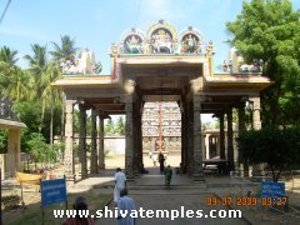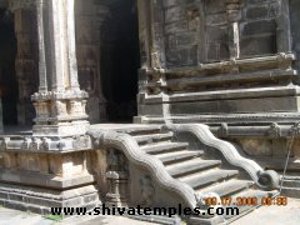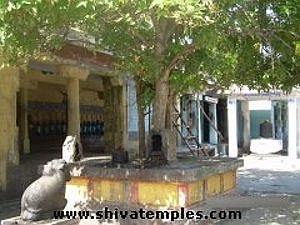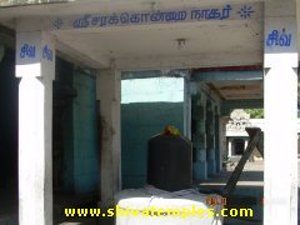Athigai Veerattanathar Temple, Tiruvathigai
Location: Tiruvathigai
Deity known as: AthigaiVeeratteswarar
Female Deity: Tripurasundari
Pathikam: Thirunavukarasar - 16, Sambandar - 1, Sundarar - 1
Gallery - Veerattanathar Temple



How to Reach
This Shiva temple is situated about 2 km southwest of Panruti, on the northern bank of the Kedilam River. Buses from Panruti to Cuddalore pass through Thiruvathigai; visitors can alight at the Thiruvathigai Temple stop and walk a short distance to reach the temple.
Temple Address
Tiruvathigai
Panruti Post
Panruti Taluk
Cuddalore District
PIN 607106
Temple hours
Morning: 6:00 AM - 12:00 PM
Evening: 4:00 PM - 8:00 PM
Near by Temples
| 1 | Tiru-Thuraiyur - 12 kms | |
| 2 | Tiru-Maanikuzhi - 16 kms | |
| 3 | Tiru-Navalur - 20 kms | |
| 4 | Tiru-Paathiri-Puliyur - 25 kms | |
| 5 | Puravaar Panankaatur - 28 kms |
Temple Legend - Tripura Samhara
Thiruvathigai stands out as one of the eight sacred sites where the valorious power of Lord Shiva was vividly displayed. It was at Thiruvathigai that Lord Shiva executed the Tripura Samhara, a significant event that took place at Thiruvathigai and it is considered as one of the eight 'Ashta veerattana sthalam'.
The Three Demons of Tripura
According to legend, three powerful demons—Vidyunmali, Tarukaksha, and Kamalaksha—lived in three impregnable moving forts collectively known as Tripura. These celestial cities were made of gold, silver, and iron, respectively. The demons caused great havoc across the universe, tormenting the celestial beings (Devas). Distressed by their suffering, the Devas appealed to Lord Shiva to destroy the tyrants and restore peace.
The Divine Chariot
In response to their plea, a magnificent celestial chariot was created—its four horses represented the four Vedas, Lord Brahma served as the charioteer, and the sun and moon formed the right and left wheels. Countless divine beings adorned the chariot and joined the cosmic army. Each member of the divine army took pride in their role, believing their contribution would ensure victory. Observing their growing pride, Lord Shiva merely smiled—his serene expression a reminder of his supreme power.
The Benevolent Smile
That radiant smile spread divine grace across the worlds. The demons of Tripura who remained devoted to Shiva were blessed with well-being, while those who strayed from devotion were destroyed. With a gentle chuckle from Lord Shiva, the three mighty forts turned to dust, marking the triumph of good over evil at Thiruvathigai.
Temples associated with Tripura Samhara:
This sacred site serves as a poignant reminder of the events that transpired, underscoring the power and benevolence of Lord Shiva in vanquishing evil forces and restoring harmony in the universe through his divine grace.
The Story of Tirunavukkarasar
Early Life
In the 7th century, a pious couple, Tiru-Pugazhanar and Mathiniyar, lived in the village of Thiruvamur in Thirumunaipadi Nadu. They had two children — a daughter, Thilagavathiar, and a son, Marulneekiar. During his youth, Marulneekiar was drawn to Jainism and joined a Jain monastery, where he was known as Dharmasena. Meanwhile, Thilagavathiar, after the passing of her betrothed, the military commander Kalipagayar, chose a life of ascetic devotion to Lord Shiva. Distressed by her brother’s conversion to Jainism, she prayed earnestly for his return to the Shaiva path.
The Divine Cure at Thiruvathigai
Around this time, Marulneekiar suffered from a severe and incurable stomach ailment. Seeking relief, he turned to his sister, who brought him to the sacred temple at Thiruvathigai. There, she gave him the temple’s holy water and sacred ash (vibuthi) as medicine, urging him to pray sincerely to Lord Shiva. It is said that the moment Marulneekiar consumed the sacred ash, his pain vanished completely. Overwhelmed with gratitude and divine grace, he composed his first hymn, beginning with the line “Kootru Aayinavaru.”
The Divine Voice
Lord Shiva was pleased by his poetic skill, and it is believed that at this point the lord's divine voice was heard saying that "Marulneekiyar will henceforth be known to the world as 'Thirunavukkarasar' (Thiru-Sri; Navu-Tongue; and Arasar-King) and that his glories will be etched in history forever".
Temple Layout and Architecture
Outer Complex
This vast Shiva temple spans nearly 7 acres, with its majestic east-facing Rajagopuram rising in 7 tiers and crowned by 7 kalasams. In front of the entrance stands the Thiruneerthu Mandapam, a striking 16-pillared hall adorned with intricate sculptures of Rishabharudar, Appar, Mayilvahanan, and a notable figure believed to have contributed to the temple’s renovation.
Along the pathway from the Rajagopuram, visitors can admire exquisite carvings of women in 108 classical dance poses. A grand sculpture of Tripura Samhara Murthy commands attention, beneath which lies another depiction of Gaja Samhara Murthy. Proceeding further, a second 16-pillared mandapam enhances the temple’s architectural grandeur.
Sacred Features
To the south of the outer courtyard lies the sacred tank, Sankara Theertham, while to the north stands a 5-foot-tall statue of Buddha in Padmasana. A five-tiered gopuram serves as the gateway to the inner sanctum, with the Dwajasthambam, Balipeetam, and a Vinayaka shrine positioned between this gopuram and the second mandapam.
Beyond the second gopuram, devotees are greeted by a majestic Nandi flanked by Ganapathy and Murugan. In the southern section of the inner prakaram are the shrines of Thirunavukkarasar and Thilagavathiar, followed by those of Bhairavar, Saneeswarar, and Goddess Durga.
Periyanayaki Sannidhi
Deeper within the complex lies the shrine of Goddess Periyanayaki, whose colorful Vimanam is visible from the entrance of this sannidhi itself. This ornate tower is adorned with vibrant sculptures, among which the depiction of Tripurantakar stands out — shown in a majestic standing posture with twelve hands, holding a trident and bow, one foot on a chariot, and the other raised high — a magnificent example of the temple’s artistic brilliance.
The Main Sanctum - Athikai Veerateshwar
Swayambhoo Lingam
The innermost third prakaram houses the sanctum of the presiding deity, Athikai Veerateswarar, enshrined as a Swayambhoo Lingam (self-manifested form of Shiva). Behind the Moolavar, Lord Shiva and Goddess Parvathi are depicted together in their Tirumana Kolam.
Unique Architecture
The Vimanam above the sanctum, dating back to the Pallava period, stands as an architectural marvel. Its design is so exceptional that it casts no visible shadow at any time of the day, enhancing the mystery and grandeur of this ancient shrine.
Garuda, Brahma, Vishnu, and the Pancha Pandavas are believed to have worshipped Lord Athikai Veerateswarar here. Their devotion adds to the temple’s deep spiritual and historical significance.
Panchamukha Lingam
In the southwest corner of the inner prakaram lies the sacred Panchamukha Lingam, an extraordinary relic from the Pallava era. This unique Lingam features four faces oriented toward the four cardinal directions, while the fifth is said to face upward — a rare sight in Tamil Nadu. Nearby, rows of Shivalingams can be seen alongside the Yagasalai, Navagraha shrines, and the Nataraja Sabha.
Lord Muruga
Lord Muruga is enshrined here with His consorts, Valli and Deivanai. Saint Arunagirinathar has sung two Thiruppugazh hymns in praise of Lord Muruga of this temple.
Historical Significance
Sundarar’s Tiruvadi Deekshai
Out of deep reverence for Saint Thirunavukkarasar, Saint Sundarar chose not to step on the temple grounds where Thirunavukkarasar had once performed Uzhavara Pani (voluntary service in cleaning and maintaining the temple). Instead, he stayed at the nearby Siddhavada Mutt and continued his worship of Athikai Veeratteswarar from there.
One night, as Sundarar slept, he felt someone touch him with their foot and then strike him lightly on the head. Startled and angered, he rebuked the unknown person—only to realize moments later that it was none other than Lord Shiva himself, granting him divine initiation, known as Tiruvadi Deekshai.
Mahendravarman I’s Conversion
King Mahendravarman I of the Pallava dynasty, originally a follower of Jainism, was converted to Shaivism through the spiritual influence of Saint Thirunavukkarasar. It is believed that the king later demolished a Jain monastery and built a Shiva temple named Gunavareswaram near Thiruvathigai, earning him the epithet Gunavareswara.
These two events — the Tiruvadi Deekshai of Saint Sundarar and the conversion of King Mahendravarman I — highlight the profound spiritual and historical importance of the Thiruvathigai temple.
Ashta Veeratta Sthalam
The temples where Lord Shiva is believed to have performed his furious dance of valor are collectively known as the Ashta (Eight) Veeratta Sthalangal. All eight of these sacred temples are located in Tamil Nadu.
More Gallery






